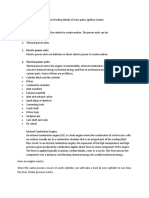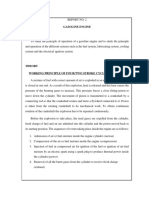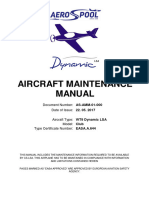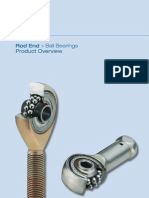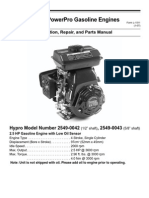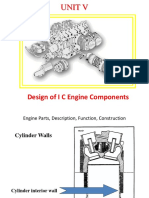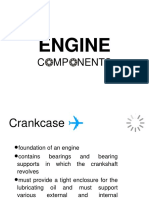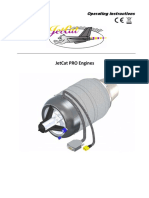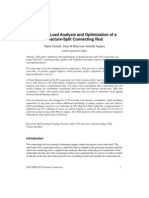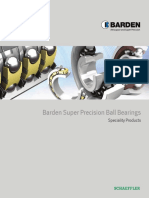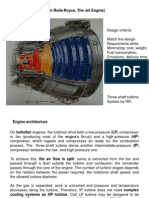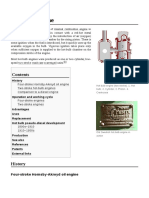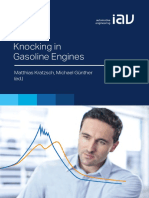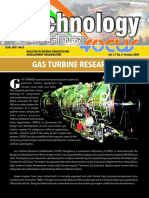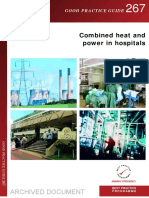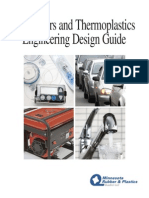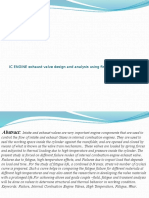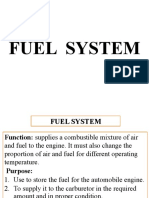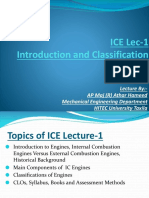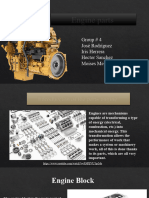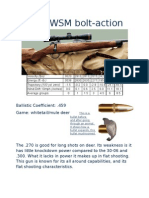Four Cylinder Gas Engine
Four Cylinder Gas Engine
Uploaded by
Jelli Anne Vistal MillanesCopyright:
Available Formats
Four Cylinder Gas Engine
Four Cylinder Gas Engine
Uploaded by
Jelli Anne Vistal MillanesCopyright
Available Formats
Share this document
Did you find this document useful?
Is this content inappropriate?
Copyright:
Available Formats
Four Cylinder Gas Engine
Four Cylinder Gas Engine
Uploaded by
Jelli Anne Vistal MillanesCopyright:
Available Formats
Four Cylinder Gas Engine
Engine-Function of Imporntant Parts in Internal Combustion Engine Internal Combustion Engine Any of a group of devices in which the reactants of combustion (oxidizer and fuel) and the products of combustion serve as the working fluids of the engine. Such an engine gains its energy from heat released during the combustion of the nonreacted working fluids, the oxidizer-fuel mixture.
Cylinder Block Is an integrated structure comprising the cylinder(s) of a reciprocating engine and often some or all of their associated surrounding structures (coolant passages, intake and exhaust passages and ports, and crankcase)
Cylinder Head In an internal combustion engine, the cylinder head (often informally abbreviated to justhead) sits above the cylinders on top of the cylinder block. It closes in the top of the cylinder, forming the combustion chamber. This joint is sealed by a head gasket. In most engines, the head also provides space for the passages that feed air and fuel to the cylinder, and that allow the exhaust to escape.
Piston Component of reciprocating engines, reciprocating pumps, gas compressorsand pneumatic cylinders, among other similar mechanisms. It is the moving component that is contained by a cylinder and is made gas-tight by piston ring.
Piston Rings A split ring that fits into a groove on the outer diameter of a piston in areciprocating engine such as an internal combustion engine or steam engine.
Connecting Rod Connects the piston to the crank orcrankshaft. Together with the crank, they form a simple mechanism that converts linear motion into rotating motion.
Gudgeon Pin The gudgeon pin is typically a forged short hollow rod made of a steel alloy of high strength and hardness that may be physically separated from both the connecting rod and piston or crosshead.
Crank Pin Hand over the power and motion to the crank shaft which come from piston ring through connecting rod.
Crank Shaft Part of anengine that translates reciprocating linear piston motion into rotation. To convert the reciprocating motion into rotation, the crankshaft has "crank throws" or "crankpins", additional bearing surfaces whose axis is offset from that of the crank, to which the "big ends" of the connecting rods from each cylinder attach.
Cam Shaft Receives oscillating motion from connecting rod and gives a rotary motions to the main shaft.
Inlet Valve and Exhaust Valve Inlet Valve allows the fresh charge of air-fuel mixture to enter the cylinder bore.Exhaust Valve permits the burn gases to escape from the cylinder bore at proper timing.
Governor It controls the speed of engine at a different load by regulating fuel supply in diesel engine.
Carburator A device that blends air and fuel for an internal combustion engine.
Fuel Pump A frequently (but not always) essential component on a car or other internal combustion engined device.
Spark Plug A device for delivering electric current from an ignition system to the combustion chamber of a spark-ignition engine to ignite the compressed fuel/air mixture by an electric spark, while containing combustion pressure within the engine.
Fuel Injector A system for admitting fuel into an internal combustion engine. It has become the primary fuel delivery system used in automotiveengines, having replaced carburetors during the 1980s and 1990s.
You might also like
- Valvula Termostatica Num. PartesDocument12 pagesValvula Termostatica Num. PartesRoberto Rueda100% (1)
- Power SystemDocument26 pagesPower Systemanandvmahadik50% (2)
- Reciprocating Engine Parts Design: G.T.U. B.E. (Mech) Sem-Viii 2011-12Document61 pagesReciprocating Engine Parts Design: G.T.U. B.E. (Mech) Sem-Viii 2011-12Divyraj JadejaNo ratings yet
- Engine Part IDocument39 pagesEngine Part Iaashish koiralaNo ratings yet
- Gasoline EngineDocument6 pagesGasoline EngineJonan TutaanNo ratings yet
- Reciprocating Engine ComponentsDocument30 pagesReciprocating Engine ComponentsManish MishraNo ratings yet
- Aircraft Maintenance Manual: Document Number: AS-AMM-01-000 Date of Issue: 22. 05. 2017Document842 pagesAircraft Maintenance Manual: Document Number: AS-AMM-01-000 Date of Issue: 22. 05. 2017Dion Satya GuntaraNo ratings yet
- 2012-005 RWG-WEB RodEnd BallBearingsDocument16 pages2012-005 RWG-WEB RodEnd BallBearingskamaleshaiahNo ratings yet
- PowerPro Gas EngineDocument16 pagesPowerPro Gas Enginefrostserv6019No ratings yet
- Structural Construction: Fuselage Wing (Mainplane) Empennage (Tailplane + Vertical Fin)Document146 pagesStructural Construction: Fuselage Wing (Mainplane) Empennage (Tailplane + Vertical Fin)Damon LeongNo ratings yet
- Applied Thermal Engineering: Prof. K. K.SHARMADocument69 pagesApplied Thermal Engineering: Prof. K. K.SHARMAKaran100% (1)
- MSD Unit 5Document32 pagesMSD Unit 5Vikas RathodNo ratings yet
- Engine ComponentsDocument31 pagesEngine ComponentsKyle Caducio100% (1)
- Mbeya Institute of Science and Technology: Power Plants Lecture No 6 Diesel Engine Power PlantsDocument68 pagesMbeya Institute of Science and Technology: Power Plants Lecture No 6 Diesel Engine Power PlantsNyandaMadili MalashiNo ratings yet
- Design Databook FinalDocument19 pagesDesign Databook FinalKumaran NarayananNo ratings yet
- Piston Engine ConstructionDocument150 pagesPiston Engine ConstructionHastian SuryaNo ratings yet
- Gas Turbine System Theory PDFDocument30 pagesGas Turbine System Theory PDFAbdul GafurNo ratings yet
- PRO Engines Instruction Manual ENGLISH V1 8 08 2019Document72 pagesPRO Engines Instruction Manual ENGLISH V1 8 08 2019jay biljanNo ratings yet
- Dynamic Load Analysis and Optimization of A Fracture-Split Connecting RodDocument11 pagesDynamic Load Analysis and Optimization of A Fracture-Split Connecting RodRahul BadgujarNo ratings yet
- Thermal Engineering I MANUALDocument35 pagesThermal Engineering I MANUALKalpit KauraseNo ratings yet
- Theory and Design of Automotive EngineDocument127 pagesTheory and Design of Automotive EnginePrasad RamaniNo ratings yet
- Unit 4 Flywheel: StructureDocument21 pagesUnit 4 Flywheel: StructureShivam Gupta0% (2)
- Barden Speciality Products Us en PDFDocument73 pagesBarden Speciality Products Us en PDFjjcadena2000No ratings yet
- Design and Analysis of Annular Combustion Chamber of A Low Bypass Turbofan Engine in A Jet Trainer AircraftDocument11 pagesDesign and Analysis of Annular Combustion Chamber of A Low Bypass Turbofan Engine in A Jet Trainer Aircraftmohammadali akhtardaneshNo ratings yet
- Seminar Powerpoint Presentation On 6 Stroke EnginesDocument31 pagesSeminar Powerpoint Presentation On 6 Stroke EnginesVijay ChauhanNo ratings yet
- Spherical Bearings Loader Slot Bearings Rod End Bearings Sleeve BearingsDocument43 pagesSpherical Bearings Loader Slot Bearings Rod End Bearings Sleeve BearingsMar SolNo ratings yet
- Turbine SystemsDocument46 pagesTurbine SystemsAmbrish Singh100% (1)
- Wankel EngineDocument15 pagesWankel EngineMuhammad Bin RiazNo ratings yet
- Hot Bulb EngineDocument12 pagesHot Bulb EngineRoberto Ortega MicalizziNo ratings yet
- Design of Piston HeadDocument7 pagesDesign of Piston HeadSouradeep BhattacharjaNo ratings yet
- GteDocument35 pagesGtejjj1728No ratings yet
- SERDI PRO Retifica UserManualDocument54 pagesSERDI PRO Retifica UserManualRafael Pertile CarneiroNo ratings yet
- Iav Ottomotorisches Klopfen Ans PDFDocument449 pagesIav Ottomotorisches Klopfen Ans PDFengrsurifNo ratings yet
- 1) Effect of Engine Speed On Intake Valve Flow Characteristics of A Diesel EngineDocument6 pages1) Effect of Engine Speed On Intake Valve Flow Characteristics of A Diesel EnginefitriasyrafNo ratings yet
- SATO FA-82B 4 Stroke Single Engine Instruction Manual: Manuals+Document11 pagesSATO FA-82B 4 Stroke Single Engine Instruction Manual: Manuals+ZamriNo ratings yet
- Technology Technology: Gas Turbine ResearchDocument12 pagesTechnology Technology: Gas Turbine ResearchDR DONo ratings yet
- Duke Engine ReportDocument9 pagesDuke Engine ReportDeepak Jindal100% (1)
- IC Engine - Lecture 1Document55 pagesIC Engine - Lecture 1darshan008No ratings yet
- What Are The Functions of An Exhaust ManifoldDocument5 pagesWhat Are The Functions of An Exhaust Manifoldjameel babooram100% (1)
- GPG267 Combined Heat and Power in Hospitals PDFDocument18 pagesGPG267 Combined Heat and Power in Hospitals PDFIppiNo ratings yet
- Finite Element Structural Analysis of Wind Turbine Gearbox ConsideringDocument7 pagesFinite Element Structural Analysis of Wind Turbine Gearbox Consideringashok_abclNo ratings yet
- Design Guide PDFDocument117 pagesDesign Guide PDFAndres FacuNo ratings yet
- Engine Valve 1Document10 pagesEngine Valve 1LokeshRathor100% (1)
- Engine FundamentalsDocument36 pagesEngine FundamentalsRahul RaiNo ratings yet
- Fuel SystemDocument20 pagesFuel SystemNem AwidNo ratings yet
- Design and Optmization of A Throttle BodyDocument11 pagesDesign and Optmization of A Throttle BodyRodrigo PassosNo ratings yet
- SI Engines & Its MaintenanceDocument42 pagesSI Engines & Its MaintenanceMuhammad FawadNo ratings yet
- Vincent TechnicalDocument58 pagesVincent TechnicalCiprian MaiorNo ratings yet
- SuperchargerDocument20 pagesSuperchargerrishirajtomar100% (8)
- Helicopter GearboxDocument9 pagesHelicopter GearboxlvrevathiNo ratings yet
- Simple Turbojet Cycle: Alberto Mag-Aso IIIDocument22 pagesSimple Turbojet Cycle: Alberto Mag-Aso IIIAlberto Mag-aso IIINo ratings yet
- Actual CyclesDocument12 pagesActual Cyclesjehadyam50% (2)
- 2K17-ICE Lecture-1Document50 pages2K17-ICE Lecture-1AbdullahJavedNo ratings yet
- 2Document13 pages2msaqibraza93No ratings yet
- Automotive TermDocument3 pagesAutomotive TermML DeshmukhNo ratings yet
- Internal Combustion Engine ManualDocument7 pagesInternal Combustion Engine Manualali sultan1No ratings yet
- Internal Combustion Engines OverviewDocument21 pagesInternal Combustion Engines OverviewRex SabersonNo ratings yet
- Air FilterDocument35 pagesAir Filteryeah yeahNo ratings yet
- Automotive EnginesDocument38 pagesAutomotive EnginesWinapon100% (1)
- Examen Ingles PDocument32 pagesExamen Ingles PJose RaNo ratings yet
- NF2KHC9PIXHJA4MT4300 ETicketDocument3 pagesNF2KHC9PIXHJA4MT4300 ETicketAnkitKeshriNo ratings yet
- M Tech - Energy-Technology Course STR and SyllabusDocument1 pageM Tech - Energy-Technology Course STR and SyllabusAnkur MaheshwariNo ratings yet
- Industrial Icp® Accelerometer: 603C91 Performance English SI Optional VersionsDocument1 pageIndustrial Icp® Accelerometer: 603C91 Performance English SI Optional VersionsKaradiasNo ratings yet
- What Functions Does The Copper Layer in PCB OfferDocument4 pagesWhat Functions Does The Copper Layer in PCB OfferjackNo ratings yet
- Prudent Race Engineering OL Brochure - 2nd EditionDocument9 pagesPrudent Race Engineering OL Brochure - 2nd EditionAakashRanjanNo ratings yet
- Inbound Sales 1555785325680Document3 pagesInbound Sales 1555785325680Shishan AhmadNo ratings yet
- Review of Shop Drawings - Steel StructuresDocument7 pagesReview of Shop Drawings - Steel Structuresعزت عبد المنعمNo ratings yet
- Security Alarm Using Ardiuno and SensorDocument20 pagesSecurity Alarm Using Ardiuno and SensorShashank KundenaNo ratings yet
- Amigo Brothers. Lesson - StoryDocument14 pagesAmigo Brothers. Lesson - StoryAndrea NguyenNo ratings yet
- Personal Development Week 1Document63 pagesPersonal Development Week 1ajbrjsny blpNo ratings yet
- Arnab Koley Bioinformatics PPT (Arnab Koley)Document6 pagesArnab Koley Bioinformatics PPT (Arnab Koley)Rakshit MittalNo ratings yet
- Reflection & EmpathyDocument20 pagesReflection & Empathyd.s100% (1)
- FINA 5190 Course Outline - 2020 - King Peng - Final VersionDocument7 pagesFINA 5190 Course Outline - 2020 - King Peng - Final VersionTak Ming ChanNo ratings yet
- Gadzella 1994Document8 pagesGadzella 1994Nerua SNo ratings yet
- Guía de Aprendizaje 1 - Actividades 3 - ConditionalsDocument3 pagesGuía de Aprendizaje 1 - Actividades 3 - ConditionalsViviana Munoz CardonaNo ratings yet
- Experiment No: 4: TITLE: 4-Bit Comparator AIM: To Design 4-Bit Comparator Using IC 7485 Prior ConceptDocument43 pagesExperiment No: 4: TITLE: 4-Bit Comparator AIM: To Design 4-Bit Comparator Using IC 7485 Prior ConceptKelvin CooperNo ratings yet
- Business Markets and Business Buyer BehaviorDocument14 pagesBusiness Markets and Business Buyer BehaviorKelia KellyNo ratings yet
- History IDocument15 pagesHistory IANMOL GOELNo ratings yet
- Company Profile - BravoFabsDocument14 pagesCompany Profile - BravoFabssong.anarNo ratings yet
- BMCC Syllabus Spring 2010Document3 pagesBMCC Syllabus Spring 2010eharte1445No ratings yet
- Friday 19 June, 2020Document2 pagesFriday 19 June, 2020Mazen FawazNo ratings yet
- 270 WSM BoltDocument1 page270 WSM Boltslugmeister100% (2)
- ZF Cat Cv-Transmission-Scania Grs905 A 4 RGB 2021-12 enDocument26 pagesZF Cat Cv-Transmission-Scania Grs905 A 4 RGB 2021-12 enSol100% (2)
- F-MPC60B Series: User's ManualDocument146 pagesF-MPC60B Series: User's Manualpika100% (1)
- Tannen 1993the Relativity of Linguistic Strategies - Gender and Disc PDFDocument18 pagesTannen 1993the Relativity of Linguistic Strategies - Gender and Disc PDFmervat_aastNo ratings yet
- Cont 682007Document6 pagesCont 682007TAHER AMMARNo ratings yet
- Pelf Infotech PVT LTD: Sbi Colony, Opp - Swapna Shilp, Kothrud, Pune - 411 038Document5 pagesPelf Infotech PVT LTD: Sbi Colony, Opp - Swapna Shilp, Kothrud, Pune - 411 038Abhijeet PatilNo ratings yet
- MICHALOUS C.V PortfolioDocument33 pagesMICHALOUS C.V Portfoliomichalou2522No ratings yet
- Sedu e 46 2004 - 0 PDFDocument6 pagesSedu e 46 2004 - 0 PDFall is well rajaNo ratings yet



